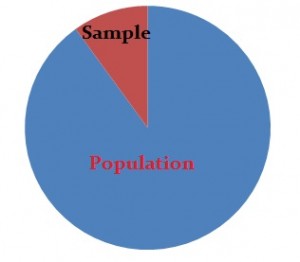Probability and Statistics > Sampling > What is a Sample?
 In statistics, you’ll be working with samples — a part of a population. For example, if you want to find out how much the average American earns, you aren’t going to want to survey everyone in the population (over 300 million people), so you would choose a small number of people in the population. For example, you might select 1,000 people.
In statistics, you’ll be working with samples — a part of a population. For example, if you want to find out how much the average American earns, you aren’t going to want to survey everyone in the population (over 300 million people), so you would choose a small number of people in the population. For example, you might select 1,000 people.
If you want your results to be meaningful and scientifically sound, you can’t just choose 10,000 people in any old way — for example, you can’t go knocking on your neighbors doors. In order for it to be statistical (i.e. one that you can use in hypothesis testing), the actual size must be found using a statistical method. Ten thousand people might not be the optimal amount for valid survey results: you may need more, or less. There are many, many ways to find sample sizes, including using data from prior experiments or using an online calculator. The calculation can be quite complex, depending on what you want to do with your data. You can find out more about how to find them here: Sample size: How to find it.
Sample Methods
If you’ve decided to assemble your sample from scratch (for example, you aren’t using prior data), then you need to choose a sampling method. Which sampling method you use depends on what resources and information you have available. For example, the draft worked by drawing random birth dates, a method called simple random sampling. In order for that to work, the government needed a list of every potential draftee’s name and date of birth. The draft could also have used systematic sampling, drawing the nth name from a list (for example, every 100th name). For that to have worked, all the names must first have been compiled on a list.
Other types include:
- Systematic: where every nth individual is chosen from a population.
- Stratified: where there are two or more very distinct, clear groups.
- Convenience or grab: when you choose people who are convenient (like neighbors or people in a club you belong to).
For more about all the different methods, see: More Sampling Methods.